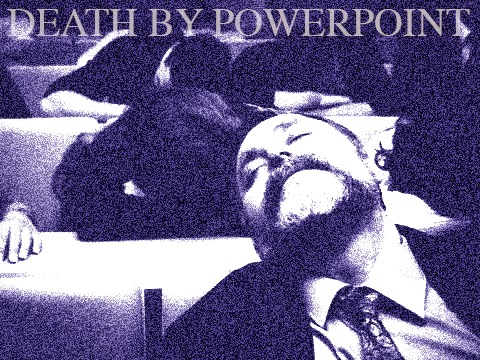Death by PowerPoint
"What did people use before PowerPoints?" I asked my wife when I got home.
"Overheads," she snapped back.
"What about before that?"
The question is really nagging at me, because as a species we have this Pavlovian response that compels us to think "slide deck" the moment we realize that we've been tasked to speak in front of people. But what did people do before? In conferences and conventions back in the days before computers, before overhead projectors, before there was any kind of technical aid to supposedly help us share information more effectively, what did they use? Chalkboards? Flip charts?
I believe that we've been duped into thinking that putting a whole bunch of words and complex drawings in a slideshow is actually furthering our cause. It is not. In fact, I'm of the mind that in most cases, it muddies the waters and adds a layer of complexity that leaves our brains confused and tired. I have done no research to back-up this claim; I don't have a fancy report to give you; and I certainly don't have a PowerPoint presentation to elucidate the issue. I just have two decades of attending conferences and seminars under my belt.
The truth is that the most memorable, engaging and moving speakers didn't use a data projector at all, they projected with the dynamics in their voice, effective story-telling, powerful pauses, and other time-tested techniques to connect with the audience. "Connect" is such an important word in this discussion, because ultimately, as a speaker you're trying to connect the content of your talk with the individuals sitting in the room. You have been tasked, at some level, with enabling a knowledge transfer and making an impression. It seems to me that paying attention to that speaker-audience relationship is key. So often, the use of PowerPoint actually diminishes that connection, and in the case of a large room, where the vast majority of the audience can't see the screen anyway, you are actually creating a barrier.
God bless Sherry Duncan from Keyano College, who illuminated my point brilliantly at the recent Resilient Communities Conference. She had pre-placed a business card in front of everyone before participating in a panel discussion. The card had the college logo on one side and the following sentence on the other: "How are our children?" She was trying to drive home the point that we have over 11,000 children in our community under the age of 6 and a desperate lack of childcare spaces. The card and its question punctuated the point in a way that was brilliant and powerful, no PowerPoint required, just some innovative thinking and being mindful of the audience.
If you held a conference where slideshows were banned, would anyone come? I suspect they would, with the promise of something unexpected, thoughtful, memorable, and most importantly, connective.
To be fair, I have seen effective use of PowerPoint, Prezi, Keynote and various other presentational programs, but only a handful of times among hundreds of tries. Blaine Legaree, a biology instructor at Keyano College did a lecture on the H1N1 crisis a number of years ago and his use of images and words (1 or 2) to add emphasis and clarity to his talk was amazing. It ranks right up there as one of the most effective and evocative presentations I have ever seen.
I would challenge anyone who regularly uses slide decks to do an audit of how it is working (or not) for your audience. You might be mortified at the response. Or, maybe they will be nice and lie, continuing the cycle of communication dysfunction for a few more generations.


Comments
Post a Comment